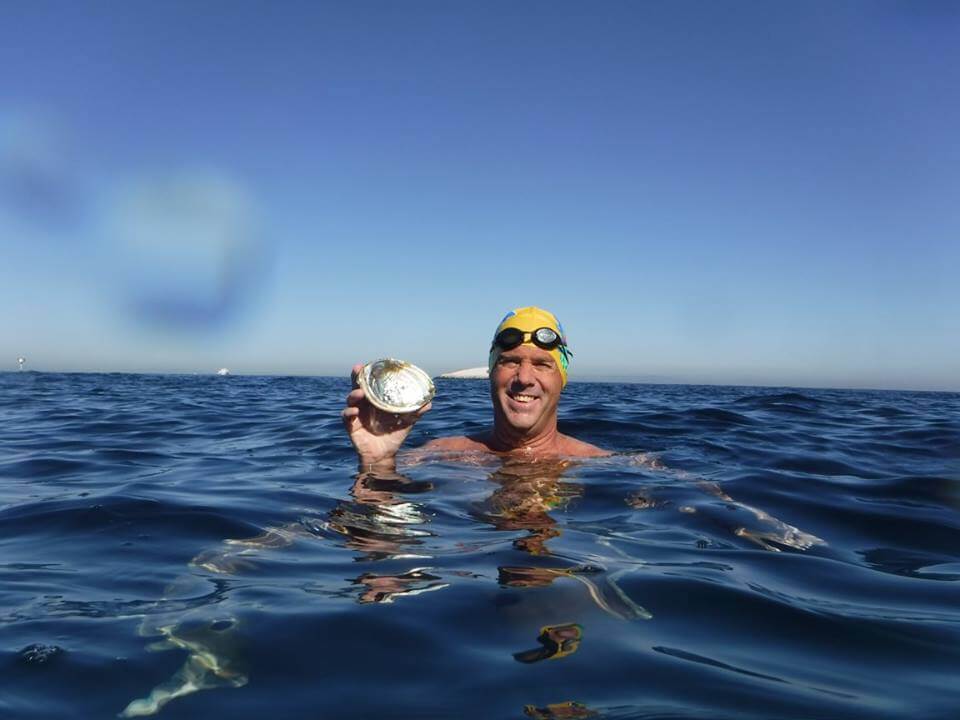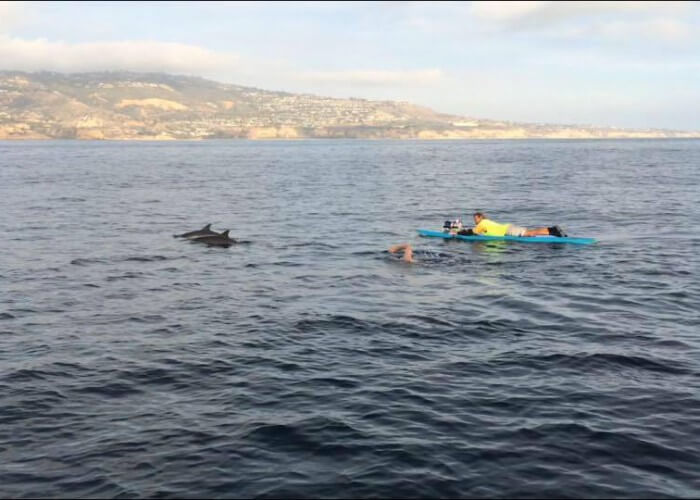How Marathon Swimmer Dan Simonelli Prepares for the English Channel

By Melissa Berkay, Swimming World College Intern
Swimming is an amazing sport. It challenges individuals to overcome obstacles, set short-term and long-term goals, be disciplined, develop time management skills, learn values of hard work and determination, and demonstrate the courage it takes to push your body to its limits. A topic consistently discussed in the sport of swimming is pool swimming. A step further into the realm of swimming that is not as exposed is open water marathon swimming. Marathon swimming is obtaining more media attention every year and the amount of swimmers who have stepped out of the pool and into the ocean for open water races has increased.
A particular individual has emerged who has inspired and continues to inspire members of the swimming community around him everyday. His name is Dan Simonelli.
Fifty-year-old Dan Simonelli has stood out in the rapid expansion of this sport. He is a father of two teenage girls and is a family man. When he is not coordinating plans and schedules with his wife and children, he is coaching athletes for channel swims such as the Catalina Channel, and other long-distance feats.
He is a head administrator and leader of the La Jolla Cove Swim Club that attracts open water swimmers of all levels to train at La Jolla Cove in San Diego, California. After successfully completing the Catalina Channel earlier this year, Dan has expressed his desire to take his long-distance swimming career to the next level.
He is currently training for the English Channel, which he plans to complete in the middle of September. Microscopically examining his training and preparation for the English Channel shows what grit and guts it takes to participate in this fascinating and rewarding sport. Simonelli shows how he trains, what he eats, and explains some pre-race logistics. Any athlete or swimmer can learn from his experience.
Preparing for The Channel
In order to complete the English Channel, Dan had to schedule his time-slot many months in advance and prepare his body for the long swim. He also had to find a strategy for proper nutrition in order to successfully complete the distance.
“There is a 7 to 10-day swim window where I will get the opportunity to complete the English Channel; each swimmer gets a window and it is dictated by the weather cycle. It changes instantaneously,” Simonelli stated.
When planning for the Channel, Simonelli explains that there are different tides- neap tide and spring tide, and three or four within a month. Most swimmers try to do the swim on a weaker tide, however Simonelli is choosing an unconventional route due to his schedule availability; he is going on a stronger tide which he has learned is less of an issue with an adjusted pace.

Photo Courtesy: Dan Simonelli
In the five months remaining of Simonelli’s training period in preparation for the English Channel, he is going to participate in a couple of Catalina Channel relays. He is also to be the “anchor” in four-person relay-crossing of the English Channel to keep himself focused, committed, and motivate to train. He will be collaborating with the renowned Chloe Mccardel by coaching and supporting her swimmers. She asked if Dan wanted to be a part of the relay.
“I am going last. I expect to swim twice. It may go to 12 hours,” Simonelli said.
Training is key for proper preparation. Simonelli’s training program encompasses the concept of periodization; the schedule is organized into weeks where one week is a build week, the second is a bulk week, the third weeks is a speed week, and the last week of the cycle is a recovery week. The “build” week consists of building up to 25 miles total while the “bulk” week consists of up to a 35-mile sum, with an accumulated “long swim” at end of week. The “long swim” usually surpasses 14 miles. The “speed week” concentrates on speed and intervals.” He learned this training concept from his friend and coach, Grace Van Der Byl. It has made a big difference in his training over the past year working up to his second SCAR swim and both Catalina Channel crossings.
“Every week of periodization is swum in open water. Recovery week is taking it easy- doing longer stuff for about two to three hours. I’m incorporating yoga into training as well. Since there are about five months to go, I am averaging 20 miles right now,” Simonelli expressed.
The Marathon Swimmer Diet
When referencing his nutrition and feeding times, Simonelli has his strategy down. He focuses on maintaining a diet filled with a low carbohydrate content. He uses UCAN products, which do not spike insulin and his goal is to have his body metabolize fat as his primary energy source. Simonelli wants his body to go straight into keto-adapted mode where his body can use his fat stores as a primary source of energy.
The culprit of unsuccessful swims is improper feeding. Sometimes an inexperienced crew think they are doing the swimmer right by overfeeding them food with a high-carbohydrate content, but end up bloating the swimmer with an excess of carbohydrates and calories. This inadvertently leads to dehydration. Simonelli has observed over 50 Catalina Channel crossings, and has interjected the feeding routines by suggesting to give the swimmer water instead of foods high in carbohydrates.
Athletes have attributed their successful crossings to Simonelli’s nutritional knowledge and feeding suggestions during their crossings. In Simonelli’s successful Catalina Channel crossing this past January, nutrition and feeding times allowed his body to conquer the distance and the temperature. He took 30 to 40 calories of UCAN per hour, and drank mostly warm water. What most athletes do is get bloated in carbohydrates and get dehydrated. The key is to keep hydrated and utilize fat sources for energy.
“There are quite a few people who are realizing that nutrition is a determining factor in the success and failure of a performance; especially during cold water swims. Olympic gold medalist Ed Moses, as well as high-profile marathon runners are a big proponent of a diet based on low-carbohydrate content. The vast majority people are consuming glucose-based products during training and racing and experience the avoidable “glucose based roller coaster,” Simonelli articulated.
Born to Swim
Swimming has been a constant in Simonelli’s life. He served in the Marine Corps. WSSI in lifeguarding water safety and survival instructor and lifeguarding on Camp Pendleton on the side. He eventually got out of the Marine Corp and lifeguarded in Oceanside, California.
In his 30s, Simonelli worked at San Diego State and started a family. His older daughter started Junior Lifeguards in 2009 and watching her practice sparked Simonelli’s inner-athete, so he began training again.
“I was overweight and started little by little. I ran between lifeguard towers in Mission Beach and swam close to shore,” Simonelli said.
A neighbor suggested he swim at La Jolla Cove, and a new chapter of his life began. He met parents from San Diego club swim teams and became an active member of the community around him.
On a higher importance level in terms of preparing for a marathon swim, Simonelli asserts the importance of mental training. He has found with swimming and coaching that one has to attend to mental training more than physical training.
“Physical is straightforward. There is something different when you have been out there six to 10 hours that you have to prepare for. There is no substitute for it,” Simonelli stated.
Simonelli loves swimming due to the meditative freedom that comes from swimming in the ocean for long periods of time. It is rewarding, healing, cleansing, and exhilarating.
“My motivation for training is to see how far I can go– where is that limit? Where is that line? You can tell yourself to get through the discomfort. A phrase Grace Van Der Byl told me has always stuck with me; she said ‘Be comfortable being uncomfortable. Allow that and don’t let the discomfort deter you.’ At some point on your swim you are going to feel like this and it is important to overcome during training. We are all products of those who have swum before us. And there are so many great people in my swimming life who have mentored and encouraged me. I’ve learned so much from each one and I wouldn’t be on the path I’m on without them all along the way. This is one of the best things about our swimming community.”
If you have not already jumped into the world of ocean swimming, give it a try! You may be surprised by what you can accomplish.




you are such an inspiration Dan!
Thanks Mary
?❤️
Lol, I actually know him! That’s crazy!
?
Say hello to your Dad
???
Ellie Mae
Geoff Toogood
Thanks coach
Kind of what we discussed Friday
See you Tuesday
Our issue is the water gets too cold in August to stay in for hours
Look forward to seeing you in Dover again – trust I get the chance to be your Observer on either your solo or relay. See you in September.
Thanks Keith ???
excellent article Dan – you are the best!!! My turn at the EC solo is 2017 – cannot wait – loads of training to do